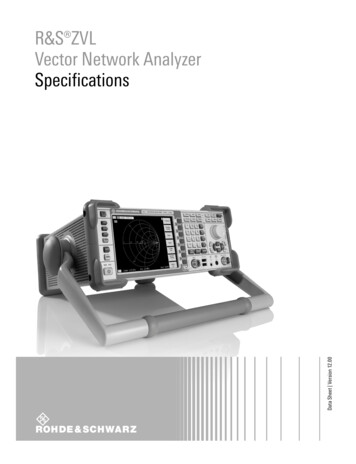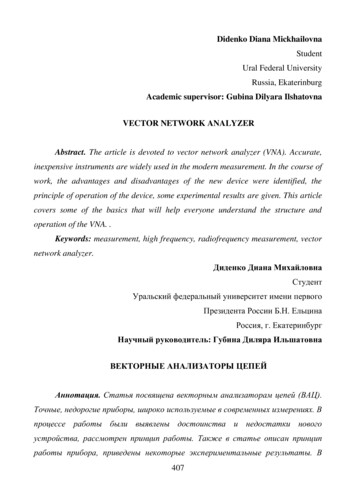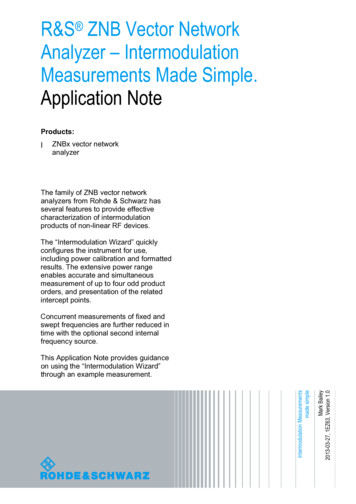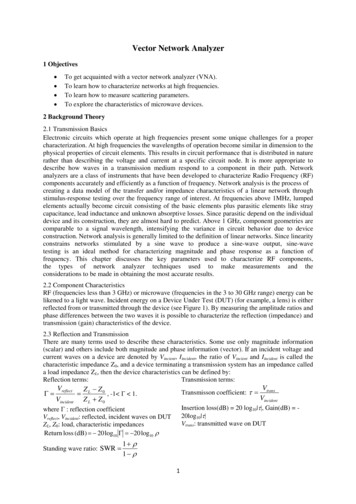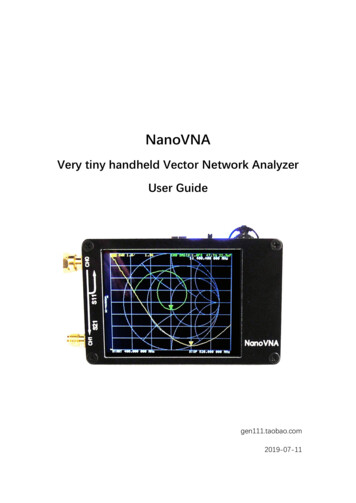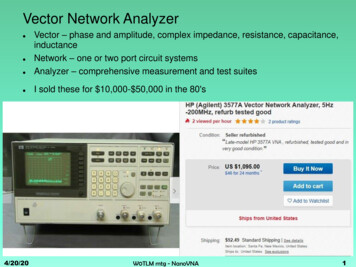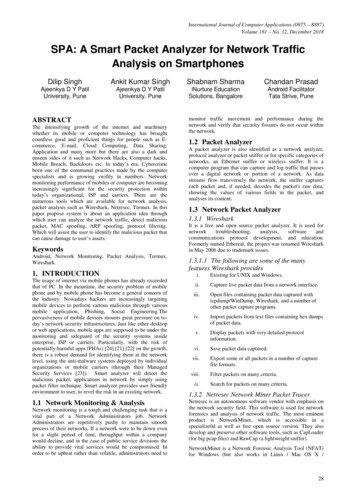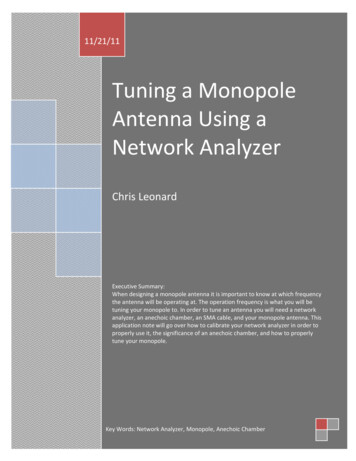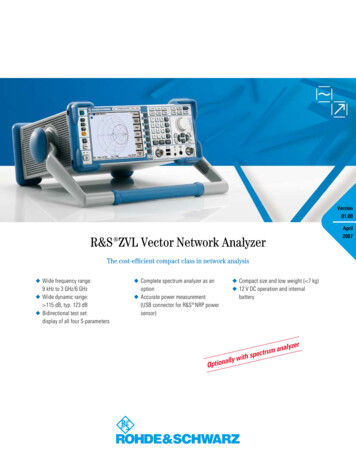
Transcription
Version01.00April2007 ZVL Vector Network AnalyzerThe cost-efficient compact class in network analysis Wide frequency range:9 kHz to 3 GHz/6 GHz Wide dynamic range: 115 dB, typ. 123 dB Bidirectional test set:display of all four S-parameters Complete spectrum analyzer as anoption Accurate power measurement(USB connector for NRP powersensor) Compact size and low weight ( 7 kg) 12 V DC operation and internal batteryy withallOptionalyzersm anpectru
Versatile – compact – future-proof ZVL Vector Network Analyzer
Network and spectrum analysis in asingle instrument Bidirectional test set for displayingall four S-parameters Multitrace display for displaying allrelevant parameters Operation with mouse orhardkeys/softkeys – convenient userinterface with wizards and contextmenus Online help – context-sensitive withremote-control commands Undo/Redo softkey for reversing upto six preceding operating steps USB connector for NRPpower sensor for precise power measurements Small and compact –37 cm instrument depth suitable forevery workbench Lightweight and portable with aweight 7 kg ZVL Vector Network Analyzer
Versatile solutionThe ZVL is a compact, powerful,and future-proof network analyzer,and is therefore ideal for use in development, production, and service.It is the only instrument to combinethe functions of a network analyzer,spectrum analyzer, and power meterin a single box, and will thus tremendously increase your work efficiency.The ZVL is ideal for lab applicationswhere the measurement tasks vary frequently; it can be used to measureS-parameters as well as the output spectrum, ACP, and TOI without havingto reconnect the device under test (DUT).With the ZVL, production linescan now be run even more flexible, asthe switchover from network analyzerto spectrum analyzer can easily be effected via remote control. Moreover,an NRP power sensor, which canbe directly connected to the ZVL,ensures precise power measurements. ZVL Vector Network AnalyzerFavorable price and high performancereduce costsThe ZVL combines a wide dynamicrange and excellent measurement speedwith versatile functionality. The segmented sweep, the multitrace display,and the powerful marker and trace evaluation are only some examples of thefunctions that speed up measurementsequences and reduce tuning and measurement times. The price/performanceratio of the ZVL makes the instrument unique among the compact network analyzers in its class.Compact dimensions and low weightsave space and facilitate mobile operationWeighing less than 7 kg and featuringan instrument depth of only 37 cm, the ZVL is by far the most compact instrument in its class. It is easy to carryand does not require much space onyour workbench. And as the ZVLcan be battery-operated, it is ideal formobile applications.Upgradeability and compatibility within the instrument family protectyour investmentNo matter what the challenge, the ZVL quickly takes it on and thusgrows with the demands. You can installhardware options as needed on-site inline with the plug & play concept. Theuser interface and the remote-controlcommand set of the ZVL are similarto those of the ZVB and ZVA.Thus, these network analyzers are interchangeable in development and production – eliminating the need to familiarizeyourself with a completely new instrument or to invest in new remote-controlprograms.
All-in-one solutionWide scope of functionsOffering excellent specifications and awide range of functions at a favorableprice, the ZVL is every development engineer's ideal network analyzer. Wide dynamic range for characterizing filters of high rejection High power-handling capability of itsreceivers for analyzing active devices Integrated step attenuator for measurements on devices with up to27 dBm output power Compact size for optimal utilization ofthe work space Simultaneous display of all relevantDUT parameters for fast tuning Possible connection of an NRPpower sensor for precise power measurement ( FSL-K9 option) Optional spectrum analysis with the FSL scope of functions– Channel and adjacent channelpower measurement– Measurement of occupied bandwidth– CCDF measurement(amplitude statistics of signals)– 20 MHz I/Q demodulation bandwidth Other spectrum analysis options arein preparationMeasurement on amplifierUniversal tool for installationand service Performance of sophisticated measurement tasks by offering networkanalysis, spectrum analysis, and power measurement in a single box Convenient loading of instrument setups with pass/fail criteria from thehard disk or USB stick Operation independent of AC supplydue to an optional internal battery or12 V car supply system Easy transportation owing to compactsize and low weight Shock-resistant housing and ergonomic carrying handle Carrying bag for accessories such asadditional batteries, power sensors,and calibration standards ZVL Vector Network Analyzer
High throughput in productionDynamic range and speed forcomplex DUTsLarge measurement bandwidths upto 500 kHz and fast synthesizers makefor short measurement times and thushigh throughput in manual tuning and automated production sequences. Dueto the analyzer's wide dynamic rangeat large measurement bandwidths, thisadvantage in speed does not affect measurement accuracy. The ZVL is thusthe ideal tool for measuring and tuningselective DUTs such as duplex filters forbase stations.Sweep modes adapted to the task reduce measurement timeUsing different sweep modes, the ZVL achieves optimal measurement times for a wide range of DUTs: For narrowband DUTs such asbandpass filters, the linear sweepwith equidistant measurementpoints is the most suitable solution. Depending on the DUT, the numberof measurement points can be selected between 2 and 4001 The ZVL measures broadbandDUTs such as cables or lowpass filters within a minimum of time byusing the logarithmic sweep. In thiscase, the step size is proportional tothe current measurement frequency The segmented sweep is ideal forfilter tuning. It allows the test pointspacing, measurement bandwidth,and source power to be specificallyset for different frequency segments.By selecting the appropriate settingin the passband and the stopband,minimum sweep times, and maximumdynamic range, and accuracy can beachievedMultitrace display ZVL Vector Network AnalyzerDynamic range at 10 Hz IF bandwidthMultitrace display for fasterDUT characterizationSeveral traces can be combined in diagrams as required and assigned todifferent measurement channels1). Thus,the ZVL characterizes DUTs using a )A measurement channel refers to an independent set oftest parameters including, for example, sweep mode,test point spacing, power, measurement bandwidth, andcalibration.variety of stimulus conditions, and simultaneously displays all relevant parameters on the screen. The names of thetraces and channels can be edited andreplaced by user- specific names to makethem easy to identify. The number oftraces is limited only by the instrument'sRAM capacity; more than 100 traces areavailable for remote-control applications,for example.
Easy and intuitive operationUser-friendly and error-tolerant evenfor complex measurement tasksThe ZVL features the triedand-tested operating concept of the ZVA and ZVB high-end network analyzers.Trace evaluation and marker functionsfacilitate manual filter tuningA wide range of trace evaluation andmarker functions support the tuning ofcomplex DUTs, such as duplex filters forbase stations. Control by mouse or hardkeys/ softkeys (whichever you prefer) Dialogs and wizards for complexfunctions quickly guide you step bystep to the required measurement Undo/Redo function for canceling upto six operating steps – including apreset, for reversing operating errorsand for fast switching between twomodes Up to 10 markers per trace in different output formats such as magnitude and phase, impedance,admittance, or VSWR Marker output formats can be selected independent of the trace format User-specific names for markers andtraces Trace evaluation functions for userdefinable frequency ranges such asmax, min, RMS, peak to peak, bandwidth, quality, etc (see figure below) Marker and pass/fail informationwindows that can be shifted and adjusted in size Output of the marker information atthe marker position, in the marker info field in the diagram, or as a tableEasy export and import of measurement results for quick documentationor comparison with a golden deviceTo make documentation easy, the ZVL provides different graphicaland data formats for exporting measurement results. Moreover, data compiledwith external tools can be loaded. Forthis purpose, the ZVL provides different formats and interfaces: Storage of measurement results internally to the hard disk or externallyto a USB memory stick Export of hard copies in *.BMP,*.WMF, or *.EMF format Export of memory and measurementtraces, e.g. as Touchstone or ASCIIfiles for further processing in spreadsheet analysis programs, MATLAB ,or simulation programs Import of Touchstone files as memory trace to compare the current measurements with simulations Import of ASCII or Touchstone files aslimit lines Context-sensitive help including detailed description of the activefunction and display of the associatedremote-control commands supportsalso untrained users and simplifiesprogramming ZVL Vector Network Analyzer
Functions and optionsNetwork analysisFunctionDescriptionMeasured quantitiesS-parameters (S11, S12, S21, S22), impedance, admittance, stabilityMeasurement formatsdB mag, lin mag, phase, polar, real, imag., Smith chart, group delay, SWR, inverted Smith chart, unwrappedphaseMarkersTen markers per trace; display in different formats; size and position of the display windows can be changedusing the mouse; editable namesMarker searchCoupled markers, max, min, peak, targetTrace evaluationMax, min, peak to peak, RMS, mean, standard deviation, electrical length, phase delay, for up to ten definable stimulus rangesBandfilter searchBandwidth, quality, attenuation, center frequency; evaluation referenced to maximum or marker valueCalibration methodTransmission and reflection normalization, OSM (full one-port), TOSM (full two-port), one-path two-portTraces, channels, and diagramsUnlimited number1) of traces and channels, overlay display of traces also of different channels in one diagram, editable names, coupled scaling of different tracesOnline helpContext-sensitive help including remote-control command documentationSweep modesLinear, logarithmic, segmented, for optimal distribution of measurement points, and bandwidth and power optimizationLimit linesUpper/lower, unlimited number of segments, use of traces as limit lines, graphical evaluation of pass/failtest, global limit test across all channelsTrace mathematicsData/Mem, Data-MemRemote-control compatibilityCompatible with the ZVA, ZVB, and instruments from other manufacturersExport of screen hardcopy*.WMF *.EMF, *.BMPData export/import*.SNP, *.CSV, *.DAT, can be read and displayed in memory tracesPower measurement( FSL-K9 option with ZVL-K1)Connection of an NRP power sensor directly to the USB interfaceUndo/RedoReversal of up to six operating steps including presetCalibration managerStorage of calibration data independent of instrument setup, assignment of stored calibration data to tracesand channelsOffsetAutomatic or manual shifting of the reference plane by a specific electrical or mechanical length; determination of phase linearity ) Limited by RAM. ZVL Vector Network Analyzer
Spectrum analysisFunctionDescriptionLevel unitsdBm, dBμV, dBmV, dBμA, dBpW, V, W, AFull selection of detectorsRMS, quasi peak, average, auto peak, pos. peak, neg. peak, sampleTOI measurementDetermination of third-order intercept point (IP3), automatic recognition of data carriers and determination ofintermodulation sidebandsHarmonic distortionAutomatic determination of harmonic distortionNoise measurement (noise marker)Noise measurement in dBm (1 Hz) using the noise marker, taking into account all necessary corrections suchas filter noise bandwidth, detector used, and averagingPhase noise measurementPhase noise measurement in dBc (1 Hz) with selectable carrier offset using the phase noise marker, takinginto account all necessary corrections such as filter noise bandwidth, detector used, and averagingChannel and adjacent channel power measurement Power measurement within a definable channel bandwidth by means of trace integration (IBW method);use of the RMS detector to ensure good repeatability and accuracy; setting of channel width by selectingfrom a list of different transmission standards or by user selection; entry of different widths for channels and adjacent channels and channel spacing for up to twelve channels and three adjacent channelsFast adjacent channel power measurementAdjacent channel power measurement with standard-specific channel filters such as RRC filters in the timedomain, reduction of measurement time by up to a factor of ten, easy measurement of the transient, time dependent adjacent channel powerBurst power measurement (time domain power)Measurement of the burst power in the time domain; display lines limit the evaluation range, e.g. to determine the power during the 147 useful bits of the GSM burstOccupied bandwidth (OBW)Measurement of the bandwidth occupied by a signal (for this purpose, the analyzer determines the channelbandwidth where 99 % of the overall power occur, for example; fully synchronous frequency sweep and highnumber of trace points ensure high measurement accuracy)Frequency counterExact determination of the signal frequency on the marker position with 1 Hz resolutionCarrier/noise ratio (C/N)Determination of the carrier-to-noise ratio referenced to 1 Hz bandwidth or a selectable bandwidth Battery pack ( FSL-B31) DC power supply ( FSL-B30) IEC/IEEE (GPIB) bus interface ( FSL-B10) OCXO ( FSL-B4) Additional interfaces ( FSL-B5)Hardware options of the ZVL ZVL Vector Network Analyzer
Specifications in briefNetwork analysisFrequency range9 kHz to 3 GHz/6 GHz (typ. 5 kHz)Measurement time (201 measurement points, full two-port calibrated) 75 msData transfer (201 measurement points)Via RSIB over 100 Mbit/s LAN1.5 msDynamic range at 10 Hz measurement bandwidth 115 dB, typ. 123 dBOutput power 0 dBm, typ. 10 dBmMeasurement bandwidths10 Hz to 500 kHz in 1/2/5 stepsWeight (without battery) 7 kg (15.43 lb)Number of channels, diagrams, and traces 1001)Number of measurement points per trace2 to 4001Operating systemWindows XPSpectrum analysisFrequency range9 kHz to 3 GHz/6 GHzFrequency uncertainty1 10–6With FSL-B4 option1 10–7Resolution bandwidthsStandard300 Hz to 10 MHz in 1/3 steps, 20 MHz at zero spanWith FSL-B7 option(1 Hz) 10 Hz to 10 MHz in 1/3 stepsVideo bandwidths10 Hz to 10 MHzI/Q demodulation bandwidth20 MHzTypical phase noise at 500 MHz–100 dBc (1 Hz), 10 kHz carrier offsetDisplayed average noise levelWithout preamplifier at 1 GHz –140 dBm (1 Hz)With preamplifier at 1 GHz –156 dBm (1 Hz), typ. –163 dBm (1 Hz)IP3 5 dBm, typ. 12 dBmDetectorspos/neg peak, auto peak, RMS, quasi peak, average, sampleLevel measurement uncertainty (95 % confidence level) 0.5 dB )10Limited by RAM. ZVL Vector Network Analyzer
Ordering informationDesignationTypeFrequency rangeOrder No.Vector Network Analyzer, 3 GHz ZVL39 kHz to 3 GHz1303.6509.03Vector Network Analyzer, 6 GHz ZVL69 kHz to 6 GHz1303.6509.06OptionsOCXO Reference Frequency FSL-B41300.6008.02GPIB Interface FSL-B101300.6208.02DC Power Supply, 12 V to 28 V FSL-B301300.6308.02NiMH Battery Pack FSL-B311300.6408.02Spectrum Analysis for ZVL ZVL-K11306.0301.01Additional Interfaces for spectrum analysis option FSL-B51300.6108.02Narrow Resolution Filters, 10 Hz to 300 Hz, for spectrum analysis option2) FSL-B71300.5601.02RF Preamplifier for spectrum analysis option FSL-B221300.5953.02 NRP Power Sensor Support for spectrum analysis option2)3) FSL-K91301.9530.021)2)2)ExtrasTest Cable (50 W)4)N(m)/N(m), 25", 630 mm/38", 960 mm (high precision) ZV-Z910 Hz to 18 GHz1301.7572.25/38N(m)/3.5 mm (f), 25", 630 mm/38", 960 mm (high precision) ZV-Z920 Hz to 18 GHz1301.7589.25/38N(m)/N(m), 24", 610 mm/36", 910 mm ZV-Z1910 Hz to 18 GHz1306.4507.24/36N(m)/3.5 mm (f), 24", 610 mm/36", 910 mm ZV-Z1920 Hz to 18 GHz1306.4513.24/36N 50 W ZV-Z210 Hz to 18 GHz1085.7099.02N 50 W ZCAN0 Hz to 3 GHz0800.8515.52N 75 W ZCAN0 Hz to 3 GHz0800.8515.72PC 3.5 ZV-Z320 Hz to 26.5 GHz1128.3501.02PC 3.5 (incl. sliding matches) ZV-Z330 Hz to 26.5 GHz1128.3518.02 RAM0 Hz to 2.7 GHz0358.5414.02Matching Pad 75 W, series resistor 25 W RAZ0 Hz to 2.7 GHz0358.5714.02Matching Pad 75 W, L section, N to BNC FSH-Z380 Hz to 1 GHz1300.7740.02Calibration KitsMatching Pad 75 W, L sectionInstruments and test equipment19" Rackmount Adapter ZZA-S3341109.4487.00Soft Carrying Bag FSL-Z31300.5401.00Additional Charger Unit FSL-Z41300.5430.02Power sensors2)5) ) ) ) ) )Average Power Sensor 200 mW NRP-Z1110 MHz to 8 GHz1138.3004.02Average Power Sensor 200 mW NRP-Z2110 MHz to 18 GHz1137.6000.02Average Power Sensor 2 W NRP-Z2210 MHz to 18 GHz1137.7506.02Average Power Sensor 15 W NRP-Z2310 MHz to 18 GHz1137.8002.02Average Power Sensor 30 W NRP-Z2410 MHz to 18 GHz1137.8502.02Average Power Sensor 200 mW NRP-Z919 kHz to 6 GHz1168.8004.02Thermal Power Sensor 100 mW NRP-Z510 Hz to 18 GHz1138.0005.02Thermal Power Sensor 100 mW NRP-Z550 Hz to 40 GHz1138.2008.02Requires FSL-B30.Requires ZVL-K1 spectrum analysis option.Requires NRP power sensor with NRP-Z3/4.One cable.Requires FSL-K9. ZVL Vector Network Analyzer11
Certified Environmental SystemISO 9001ISO 14001DQS REG. NO 1954 QMDQS REG. NO 1954 UMFor specifcations, see PD 5213.8150.22and www.rohde-schwarz.com(search term: ZVL)www.rohde-schwarz.comEurope: 49 1805 12 4242, customersupport@rohde-schwarz.comUSA and Canada: 1-888-837-8772, customer.support@rsa.rohde-schwarz.comAsia: 65 65 130 488, customersupport.asia@rohde-schwarz.com is a registered trademark of Rohde & Schwarz GmbH & Co. KG · Trade names are trademarks of the owners · Printed in Germany (sk)PD 5213.8150.32 · Version 01.00 · April 2007 · ZVL · Data without tolerance limits is not binding · Subject to changeCertified Quality System
ZVL Vector Network Analyzer The ZVL is a compact, powerful, and future-proof network analyzer, and is therefore ideal for use in devel-opment, production, and service. It is the only instrument to combine the functions of a network analyzer, spectrum analyzer, and power meter in a single box, and will thus tremen-
